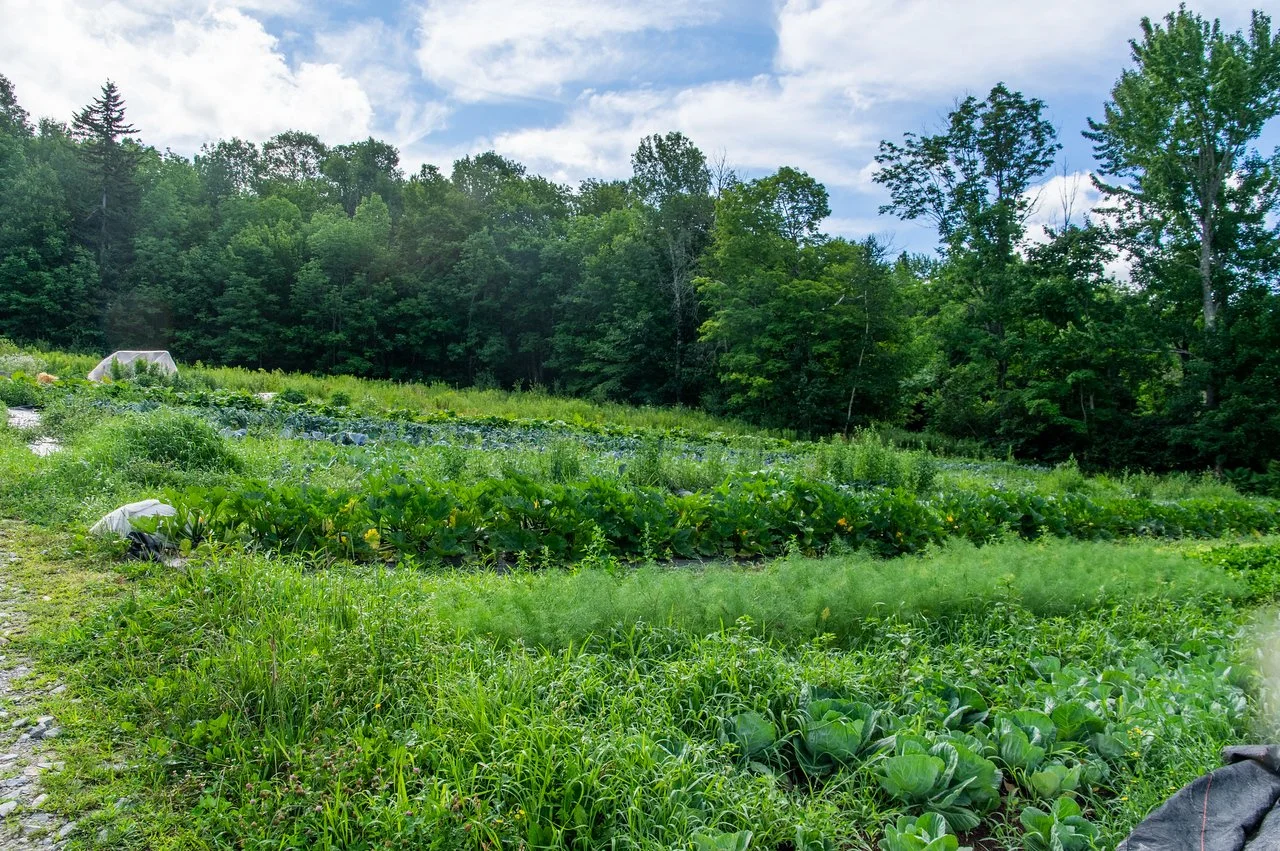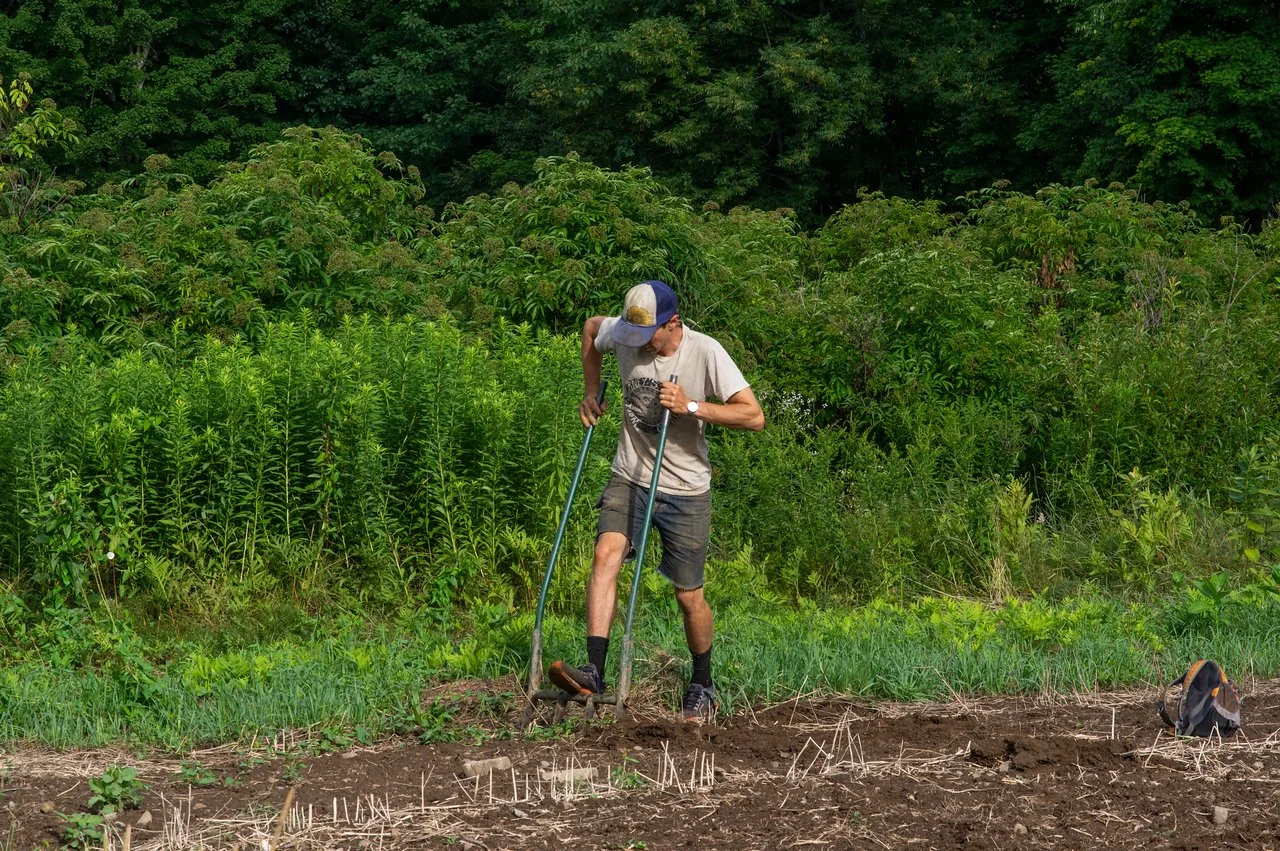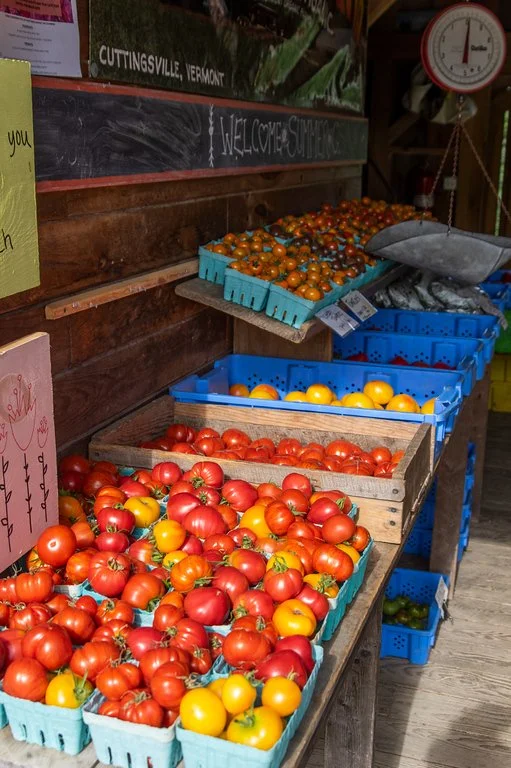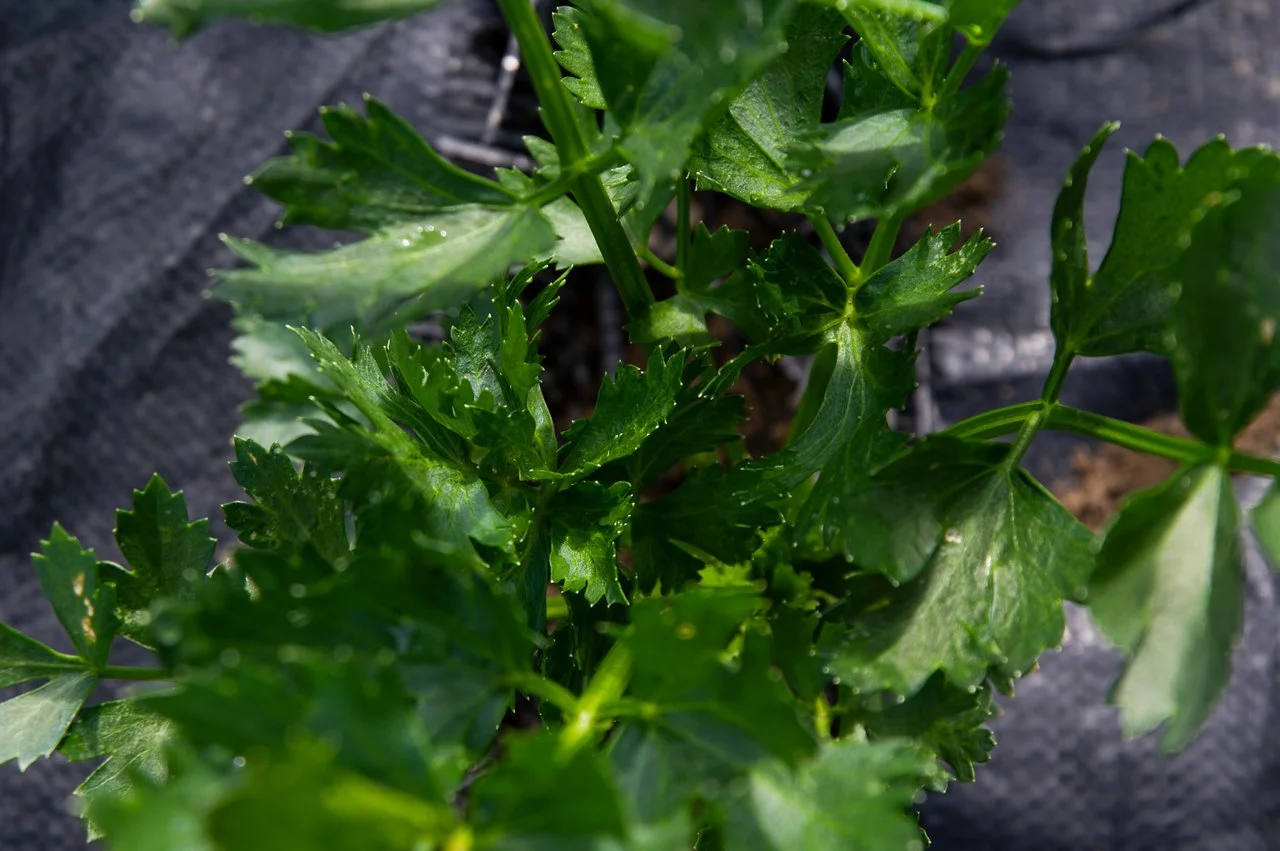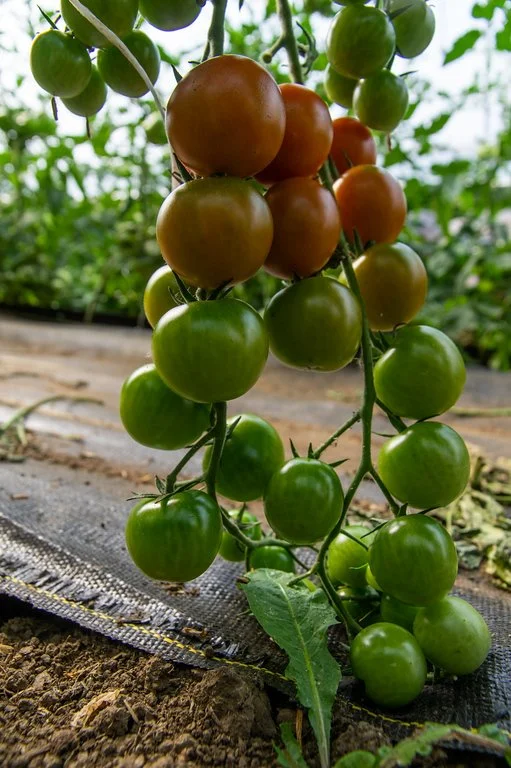9th Week of the Summer CSA season: Week of August 2nd
Barn through the flower garden. Photo by Adam Ford
CSA Balance Due
If you haven’t already paid, your balance is due. You can pay online through your account, mail a check to Evening Song Farm 48 Nice Road, Cuttingsville VT 05738, or leave a check in the CSA cash box at the barn. It’s very cool to pay in smaller chunks, just let us know what your payment plan is. You can also email or call us to pay with EBT.
If you get an email reminder that CSA payment is due: make that payment, let us know when you will be able to, or let us know if the amount due seems wrong. It adds a lot of extra computer time to try to repeatedly follow up with folks individually, so this is a simple way to lighten our administrative work. (Some of the auto emails have been a little funky, so we are happy to answer those questions if you get a weird one.) Thank you!
heirloom tomato pints, photo by Adam Ford.
Cabbage, fennel, celery, and zucchini growing in the open field, photo by Adam Ford
This Week’s Availability
This week we will have heirloom tomatoes, beefsteak tomatoes, grape tomatoes, cherry tomatoes, celery, fennel, new red potatoes, garlic scapes, purple kohlrabi, basil, parsley, green cabbage, red beets, yellow beets, baby lettuce, green curly kale bunches, lacinato kale bunches, zucchini, summer squash, slicing cucumbers, Japanese cucumbers, garlic bulbs, fresh onion bunches, and carrots.
This week we’re harvesting the first of the beautiful fresh onions. The greens are really nice, and can be used just like scallions, cooked or raw.
Ordering closes at noon on Tuesdays for Wednesday bags, and at midnight on Wednesdays for Friday bags.
You do not need to fill out the form if you plan to come to the barn on Tuesdays, Wednesdays or Thursdays to pick out your items yourself.
If you have any trouble using the online to order your veggies this week (or change your pickup location, or skip this week, or anything…) reach out to us. It’s easy to help.
Fresh onions look good, photo by Adam Ford
A bucket and staples next to the growing leeks, photo by Adam Ford
This corner of one field had a lot of bindweed, which predominantly propagates by rhizomes that spread horizontally in the soil. It’s a difficult weed to control. We used pigs many years ago to tame the bindweed in some fields. Here Ryan is removing many of the rhizomes with a broadfork. photo by Adam Ford
Jake works through a more dense bindweed patch. photo by Adam Ford
Farm News
It’s especially exciting for us to see the new building begin to be framed across the driveway from the barn. It’s been a long process…sitework began last September for the foundation, and we poured the slab and retaining walls last November. This winter we harvested ash and pine logs, and in spring our neighbor, Podge, milled those logs into posts, beams, rafters, and 2x4’s. Now Terry Martin and his crew are here to frame and roof this new solar shed. Terry’s crew did the framing, windows, and roofing for the barn in 2012, and for our home in 2013. We’re grateful they’re able to come back to do all this work to build this shed for our farm….this building will be used to store tools, supplies, be a work space for carpentry or other projects, and with solar panels on the large south-facing roof, will allow our farm to produce all of the electricity we use.
It was fun to see so many people walk through the flower garden and pick some flowers this week too. There are so many flowers that will bloom over the next few weeks, and it will be really fun to see that garden transform into the fall. (And we really hope to find time to make those signs for the pick your own herb section for this week!)
On the farm, we’ve done an amazing job catching up from our very busy season of May through early July. All of our garlic—about 12,000 bulbs—is harvested and drying, we’ve gotten through most of the big weeding projects, and many of our fall storage crops are in the ground off to a good start.
ESF Team: Ryan, Kara, Molly, Taylor, K2, Galen, Katie, Cindy, Miguel, Vanessa, Jake, Regan, (and Sky, and Soraya)
Climate Questions Answered
Jake here! We’ve had some pretty hot days on the farm recently, which got me wondering about how climate change is playing out in Vermont. Luckily, a group of researchers from UVM have recently released the Vermont Climate Assessment report. It’s an impressively thorough document (over 500 pages long!) While I haven’t read the whole thing, I thought I could share some nuggets that stood out to me. If you want to check out the source material yourself, I highly recommend the “Executive Summary”, which highlights key findings from each of the report’s ten chapters.
Here are my takeaways:
Vermont has gotten warmer. The average warming in Vermont since 1900 is about 2 °F. By coincidence, that’s roughly the same as the globally-averaged warming over that same period. Vermont may be exceptional in many ways, but in terms of climate warming, it is solidly average!
Vermont winters are warming fastest. Winter temperatures in Vermont have increased by 3.3 °F, faster than the annual average. By contrast, summer and fall temperatures have increased by only about 1.5 °F, and spring temperatures have barely changed. Incidentally, this “fastest warming in winter” pattern is occurring globally, and it takes us to the frontier of climate research — although scientists are confident in our observations of this phenomenon, we don’t yet have a good explanation for why it’s happening.
The freeze-free season has gotten longer. This is to be expected given the fast-warming winters, but I was surprised by the magnitude of this trend: The freeze-free season has lengthened by 3 weeks since 1960. Based on our current carbon emissions trajectory, the freeze-free season is expected to lengthen by another 2–3 weeks by the year 2050. These changes will likely allow farmers to experiment with new crops or practices not previously viable in Vermont.
Vermont has gotten wetter. Precipitation in Vermont has increased by about 20% since the early 1900s (an increase of 7.5 inches of water per year). Along with this increase in average precipitation, the number of days of heavy precipitation (more than 1 inch falling in a 24-hour period) has increased from about 6 days per year to about 8 days per year. Of course, those heavy precipitation days present the biggest flooding risks for farms like Evening Song.
These trends will continue as long as carbon dioxide emissions continue. Projections of Vermont’s climate future show an additional warming of 5–10 °F by the year 2100, depending on how extensively we continue to rely on fossil fuels. Personally, I’m not sure I would have made it through those hot days of farmwork last week if there had been an additional 10 °F of heat to deal with! Increases in precipitation, too, are expected to continue as long as carbon emissions continue.
Those are my big-picture takeaways. I’ve focused on climate-related changes themselves, but there’s a lot more to dig into in the report about the impact of these changes on ecosystems, on human health, and on classic Vermont pastimes such as skiing and maple sugaring (bad news about those last two, I’m afraid).
I hope this has been thought-provoking, and keep those climate questions coming!
The first posts go up on the new building, photo by Adam Ford
It took only a few days to get the main frame up, photo by Adam Ford
We needed to dig holes and pour concrete for the posts that will support the shed roof on the new building. Here Cindy is taking the formboards off the concrete footing, photo by Adam Ford
As the sugar snap peas finish, we removed them from the field to make room for a fall cover crop, photo by Adam Ford
Cucumber tendril around a little cuke, photo by Adam Ford
So many tomatoes on display in the barn, photo by Adam Ford.
Celeriac growing in the field, photo by Adam Ford
A load of garlic coming up to dry, photo by Ryan Fitzbeauchamp
The arch is becoming more laden with morning glories, photo by Adam Ford
Cherry tomatoes ripening on the vine, photo by Adam Ford
Sky was excited to tell something to Adam, photo by Adam Ford
Flower garden seed from the rafters of the new building, photo by Ryan Fitzbeauchamp



